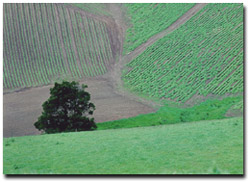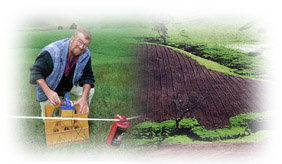
Snow peas on a steep slope near the Bass River. Steep slope and up and down cultivation increases the likelihood of soil and nutrient loss. Photos by: Rawdon Sthradher (Fine Focus Photography). |
- Try to leave a strip of pasture at intervals on slopping cultivated land to intercept run-off and break long slopes of continuous cultivation. Leave natural drainage lines grassed and consider sediment traps, diversion banks and semi permeable barriers such as straw bales and flood detention dams. Run-off should be diverted onto undisturbed areas and vegetation in order to trap sediment and encourage infiltration of water.
- To help prevent loss with run-off, fertiliser can be incorporated into the soil when cultivating.
|



